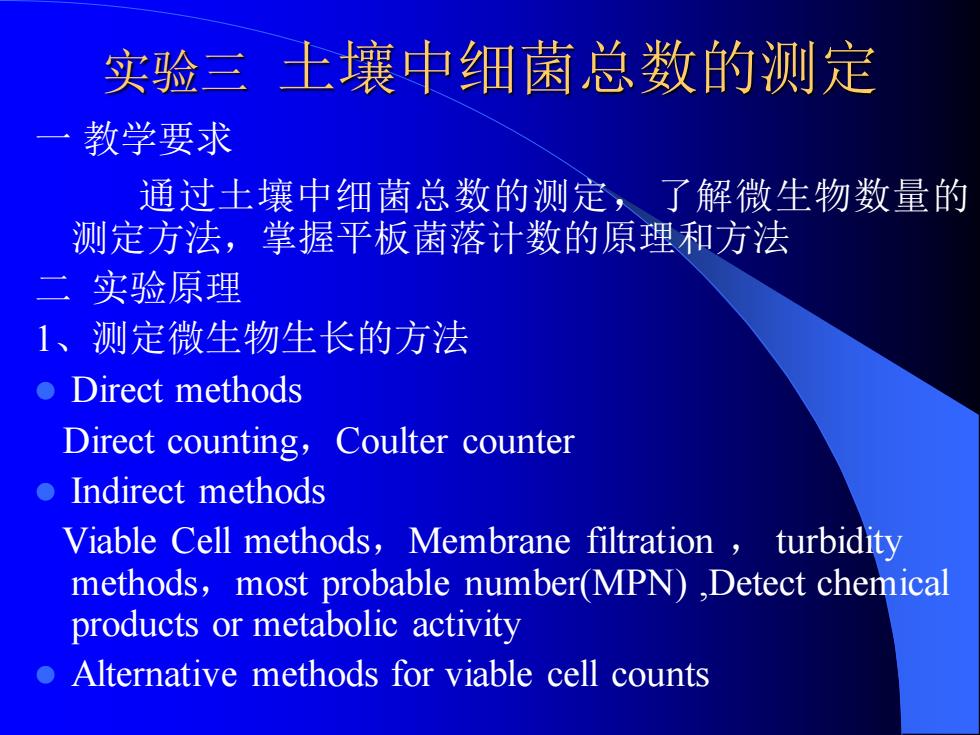
实验三 土壤中细菌总数的测定 一 教学要求 通过土壤中细菌总数的测定,了解微生物数量的 测定方法,掌握平板菌落计数的原理和方法 二 实验原理 1、测定微生物生长的方法 ⚫ Direct methods Direct counting,Coulter counter ⚫ Indirect methods Viable Cell methods,Membrane filtration , turbidity methods,most probable number(MPN) ,Detect chemical products or metabolic activity ⚫ Alternative methods for viable cell counts
实验三 土壤中细菌总数的测定 一 教学要求 通过土壤中细菌总数的测定,了解微生物数量的 测定方法,掌握平板菌落计数的原理和方法 二 实验原理 1、测定微生物生长的方法 ⚫ Direct methods Direct counting,Coulter counter ⚫ Indirect methods Viable Cell methods,Membrane filtration , turbidity methods,most probable number(MPN) ,Detect chemical products or metabolic activity ⚫ Alternative methods for viable cell counts
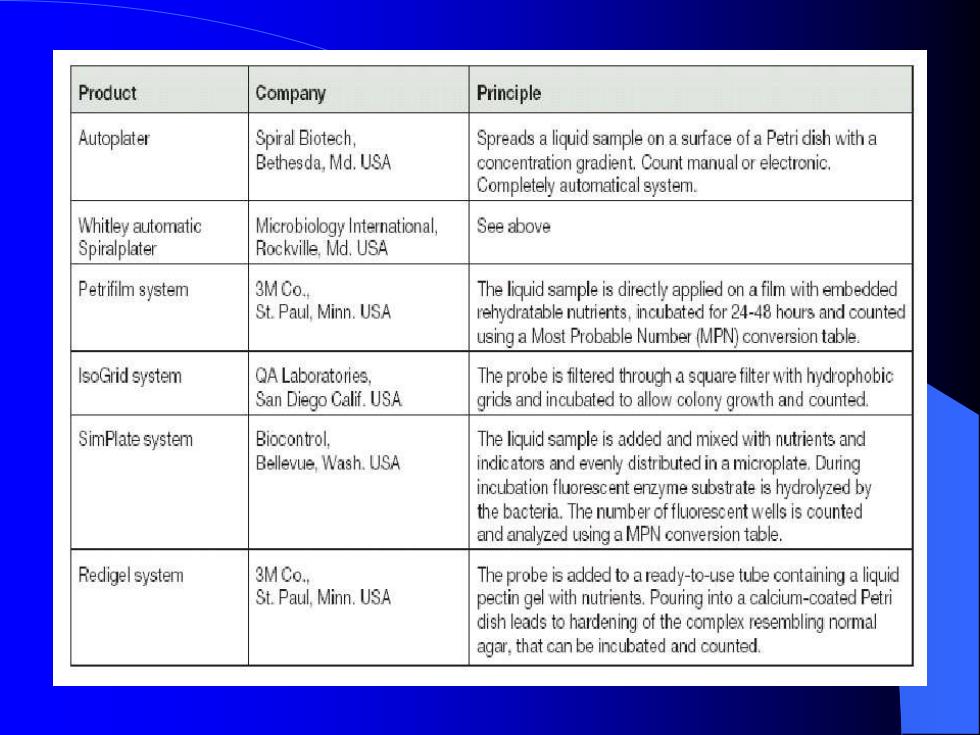
Product Company Principle Autoplater Spiral Biotech Spreads a liquid sample on a surface of a Petri dish with a Bethesda,Md.USA concentration gradient.Count manual or electronic. Completely automatical system. Whitley automatic Microbiology International. See above Spiralplater Rockville.Md.USA Petrifilm system 3MCo. The liquid sample is directly applied on a film with embedded St.Paul,Minn.USA rehydratable nutrients,incubated for 24-48 hours and counted using a Most Probable Number (MPN)conversion table. IsoGrid system QA Laboratories, The probe is filtered through a square filter with hydrophobic San Diego Calif.USA grids and incubated to allow colony growth and counted. SimPlate system Biocontrol. The liquid sample is added and mixed with nutrients and Bellevue,Wash.USA indicators and evenly distributed in a microplate.During incubation fluorescent enzyme substrate is hydrolyzed by the bacteria.The number of fluorescent wells is counted and analyzed using a MPN conversion table. Redigel system 3MCo. The probe is added to a ready-to-use tube containing a liquid St.Paul,Minn.USA pectin gel with nutrients.Pouring into a calcium-coated Petri dish leads to hardening of the complex resembling normal agar,that can be incubated and counted


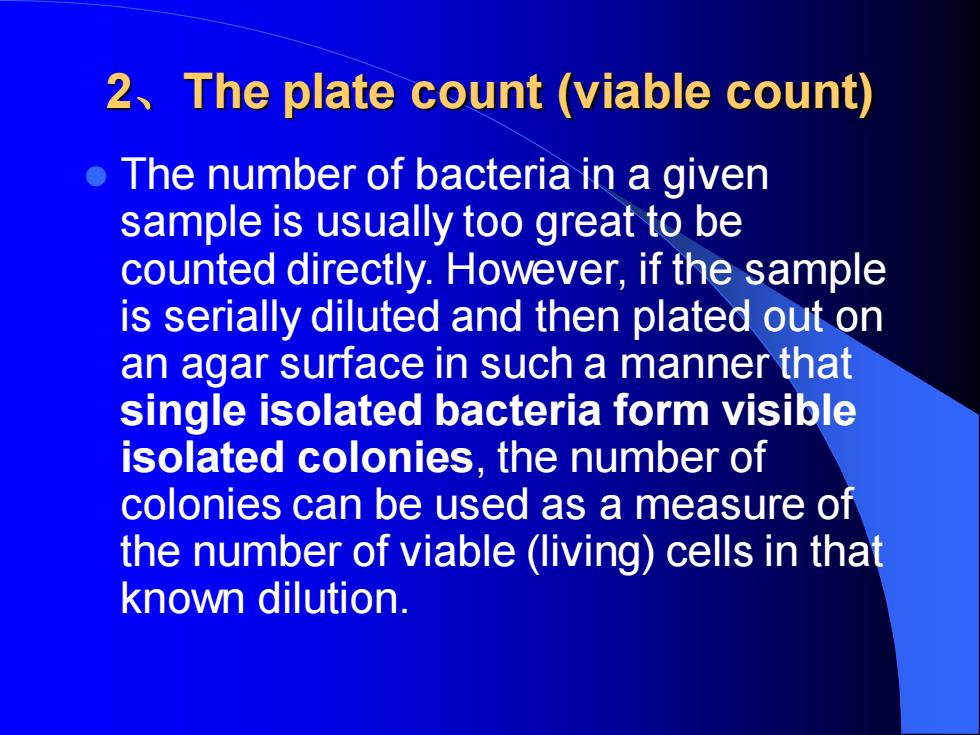
2、The plate count (viable count) ⚫ The number of bacteria in a given sample is usually too great to be counted directly. However, if the sample is serially diluted and then plated out on an agar surface in such a manner that single isolated bacteria form visible isolated colonies, the number of colonies can be used as a measure of the number of viable (living) cells in that known dilution
2、The plate count (viable count) ⚫ The number of bacteria in a given sample is usually too great to be counted directly. However, if the sample is serially diluted and then plated out on an agar surface in such a manner that single isolated bacteria form visible isolated colonies, the number of colonies can be used as a measure of the number of viable (living) cells in that known dilution
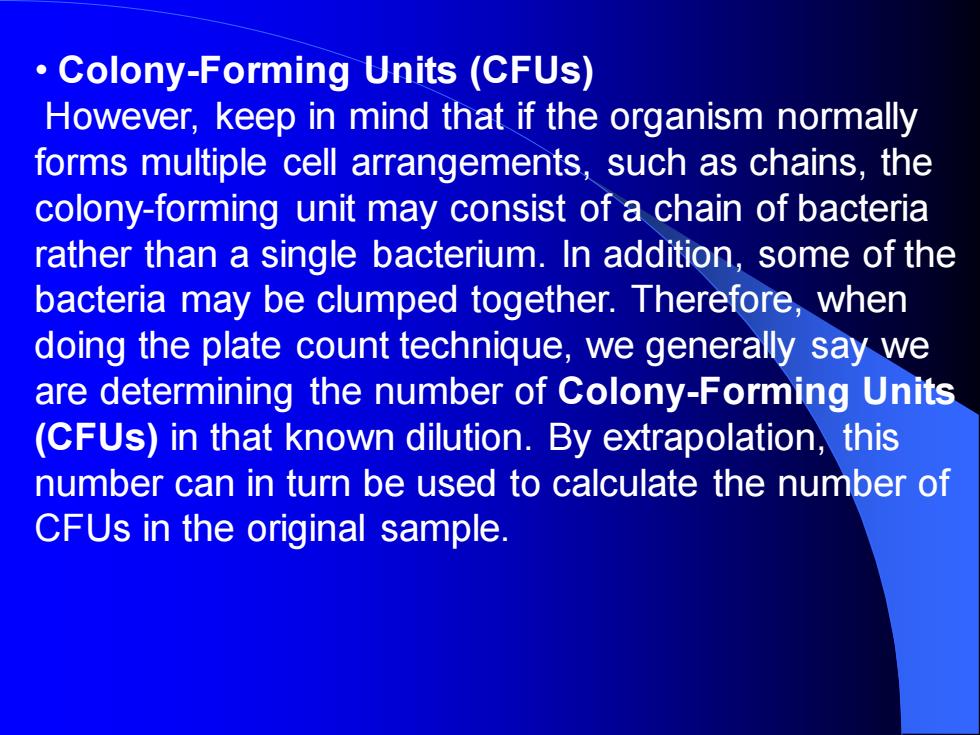
• Colony-Forming Units (CFUs) However, keep in mind that if the organism normally forms multiple cell arrangements, such as chains, the colony-forming unit may consist of a chain of bacteria rather than a single bacterium. In addition, some of the bacteria may be clumped together. Therefore, when doing the plate count technique, we generally say we are determining the number of Colony-Forming Units (CFUs) in that known dilution. By extrapolation, this number can in turn be used to calculate the number of CFUs in the original sample
• Colony-Forming Units (CFUs) However, keep in mind that if the organism normally forms multiple cell arrangements, such as chains, the colony-forming unit may consist of a chain of bacteria rather than a single bacterium. In addition, some of the bacteria may be clumped together. Therefore, when doing the plate count technique, we generally say we are determining the number of Colony-Forming Units (CFUs) in that known dilution. By extrapolation, this number can in turn be used to calculate the number of CFUs in the original sample
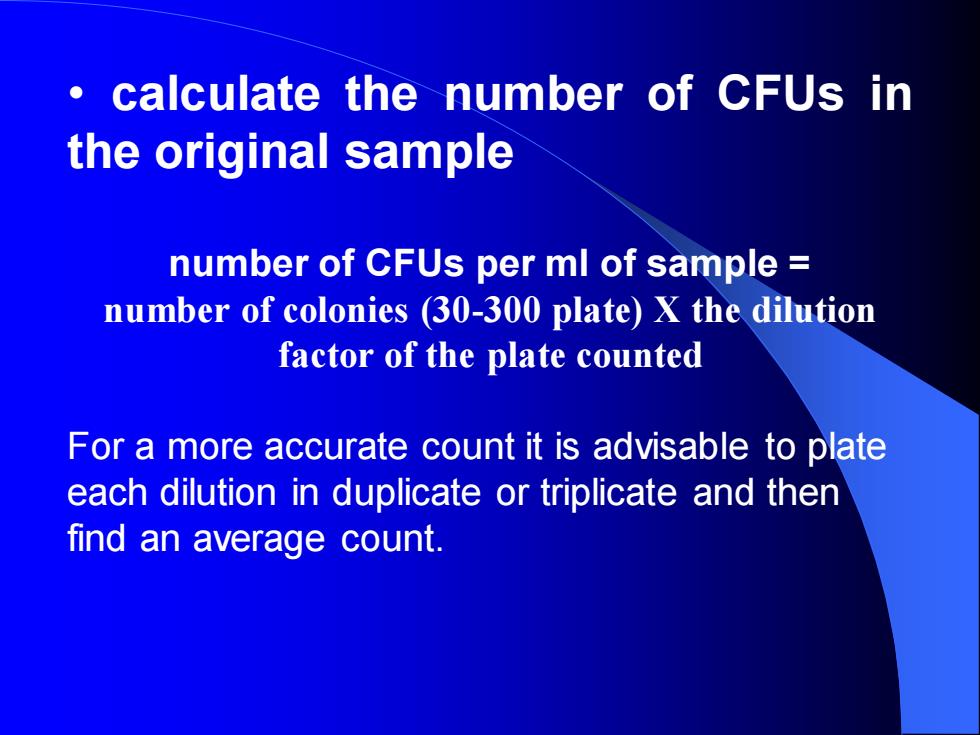
• calculate the number of CFUs in the original sample number of CFUs per ml of sample = number of colonies (30-300 plate) X the dilution factor of the plate counted For a more accurate count it is advisable to plate each dilution in duplicate or triplicate and then find an average count
• calculate the number of CFUs in the original sample number of CFUs per ml of sample = number of colonies (30-300 plate) X the dilution factor of the plate counted For a more accurate count it is advisable to plate each dilution in duplicate or triplicate and then find an average count
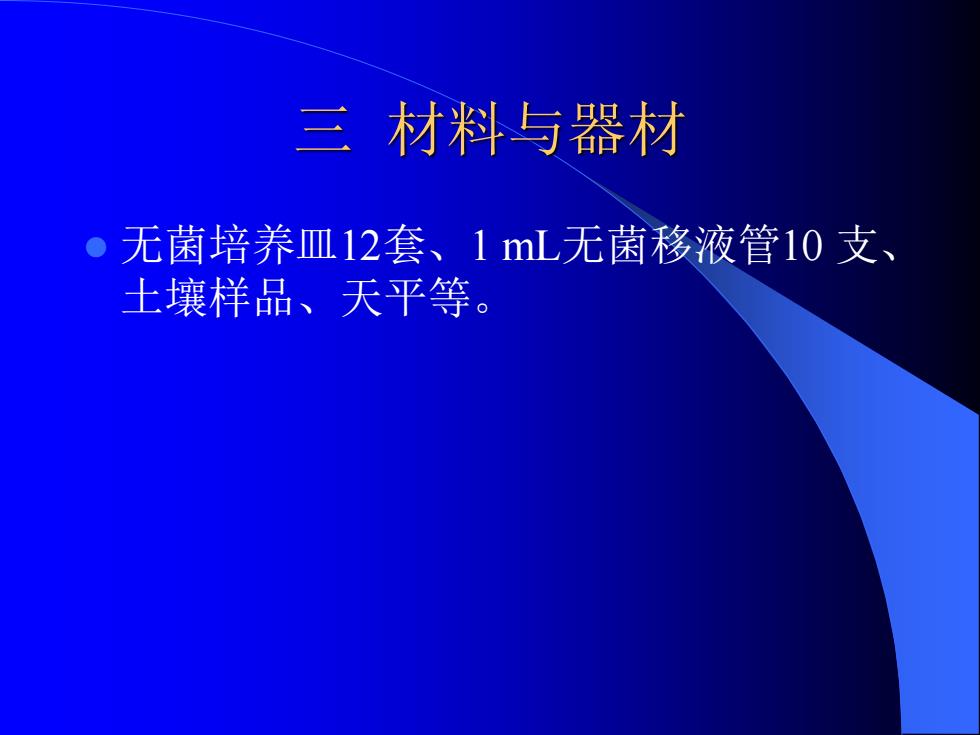
三 材料与器材 ⚫ 无菌培养皿12套、1 mL无菌移液管10 支、 土壤样品、天平等
三 材料与器材 ⚫ 无菌培养皿12套、1 mL无菌移液管10 支、 土壤样品、天平等
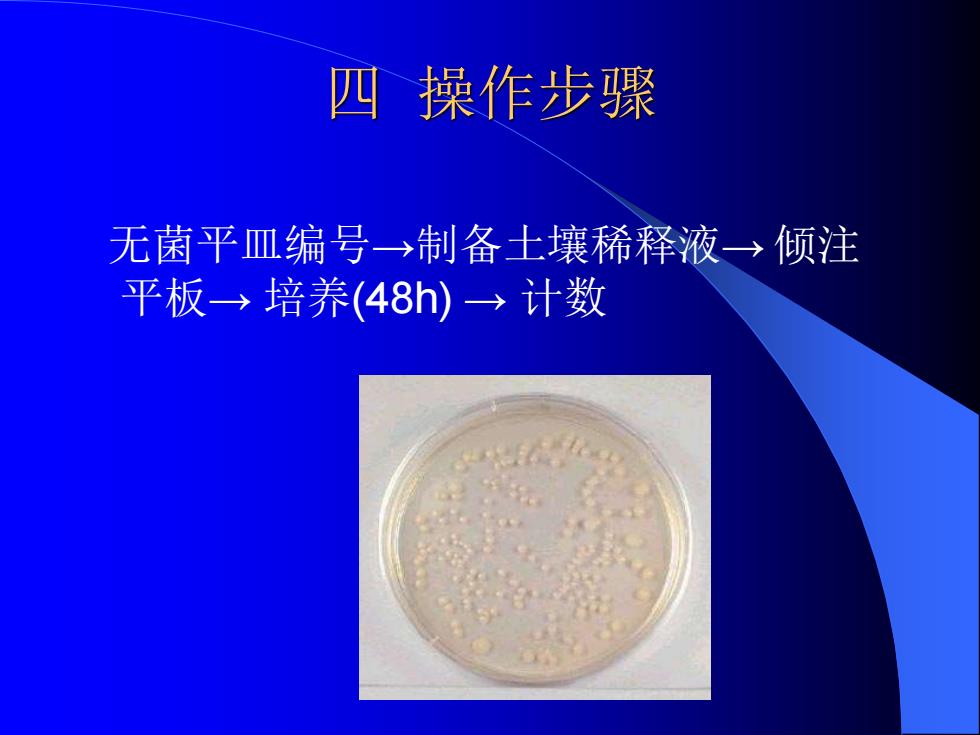
四 操作步骤 无菌平皿编号→制备土壤稀释液→ 倾注 平板→ 培养(48h) → 计数
四 操作步骤 无菌平皿编号→制备土壤稀释液→ 倾注 平板→ 培养(48h) → 计数
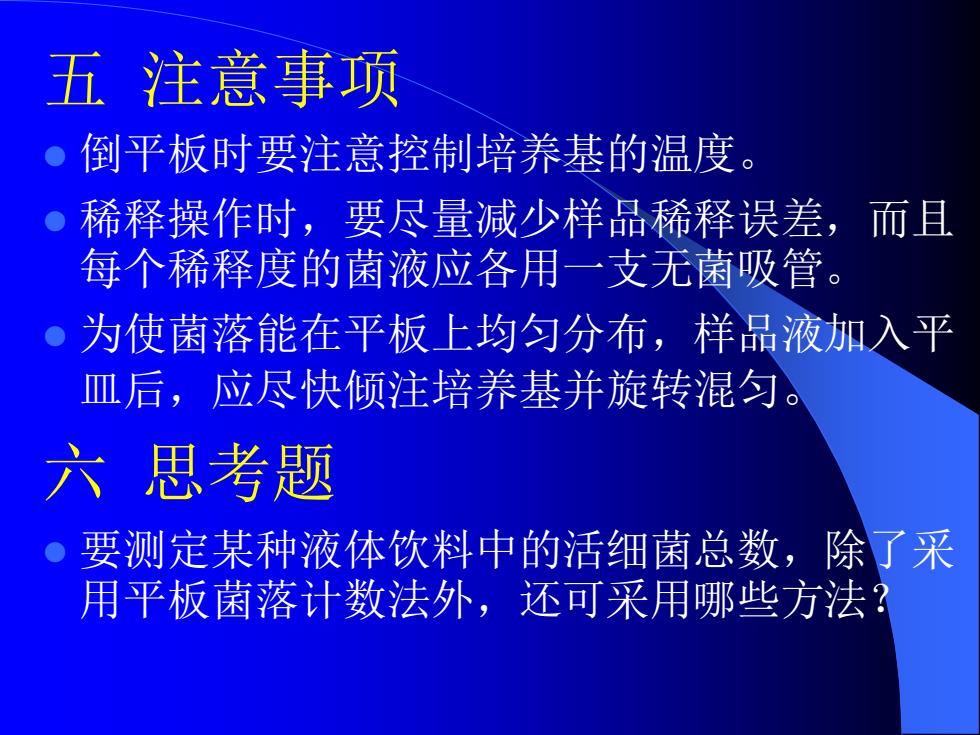
五 注意事项 ⚫ 倒平板时要注意控制培养基的温度。 ⚫ 稀释操作时,要尽量减少样品稀释误差,而且 每个稀释度的菌液应各用一支无菌吸管。 ⚫ 为使菌落能在平板上均匀分布,样品液加入平 皿后,应尽快倾注培养基并旋转混匀。 六 思考题 ⚫ 要测定某种液体饮料中的活细菌总数,除了采 用平板菌落计数法外,还可采用哪些方法?
五 注意事项 ⚫ 倒平板时要注意控制培养基的温度。 ⚫ 稀释操作时,要尽量减少样品稀释误差,而且 每个稀释度的菌液应各用一支无菌吸管。 ⚫ 为使菌落能在平板上均匀分布,样品液加入平 皿后,应尽快倾注培养基并旋转混匀。 六 思考题 ⚫ 要测定某种液体饮料中的活细菌总数,除了采 用平板菌落计数法外,还可采用哪些方法?